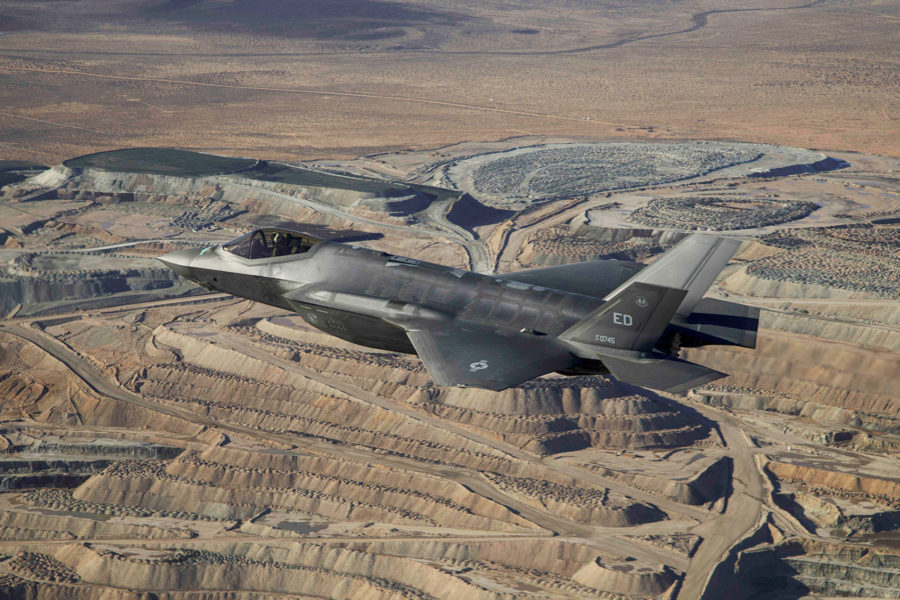The F-35 Joint Program Office is challenging the title of the Government Accountability Office’s most recent assessment of the multinational fighter, saying it implies the F-35 is getting more expensive to operate when the opposite is true.
The GAO report: “F-35 Sustainment: Costs Continue to Rise While Planned Use and Availability Has Decreased,” issued April 15, “highlights affordability and readiness challenges, all of which are known to the F-35 enterprise,” the JPO said in a press statement. It also said the report accurately notes “key program affordability and sustainment progress,” including good news on sustainability.
“We are aggressively executing near-term initiatives and long-term strategies to drive down cost and maximize availability and mission capability across the F-35 fleet,” the JPO said in a statement. “The reality is that actual aircraft Cost Per Tail Per Year and Cost Per Flight Hour continue to decrease.”
The program “achieved a 34% improvement in DoD F-35 Cost per Tail per Year (CPTPY) between 2014-22 ($9.4M to $6.2M) and a 61% improvement in DoD F-35 Cost per Flying Hour (CPFH) between 2014-22 ($86.8K to $33.6K)” all in constant year 2012 dollars, the JPO said.
“Despite economic and supply chain headwinds, we are continuing to inject affordability into this program,” it added.
While the GAO accurately notes overall program cost increases, those are due to “an extended F-35 service life and requirements growth.” Between 2018 and 2023, “the F-35’s estimated lifecycle end date [was] extended from 2077 to 2088,” and that 11-year increase in operations and continuation of the logistics enterprise drove increases referenced by GAO. The F-35 program is required to calculate comprehensive overall costs from spare parts to fuel to organic maintenance hours over a 52-year period.
“The F-35 JPO remains an open and committed partner to the GAO’s oversight mission. We will continue our productive relationship with auditing and accountability stakeholders as we work together to maximize F-35 affordability and readiness,” a JPO spokesperson said.
The key hangup on the F-35 are delays in getting the Technology Refresh 3 (TR-3) hardware and software tested and approved for fleet use. While testing is underway, newly-built F-35s are being sent directly into storage.
Testifying before the tactical aviation panel of the House Armed Services Committee April 16, F-35 Program Executive Officer Air Force Lt. Gen. Michael Schmidt declined to say how many F-35s are now in storage, or where they are, not wanting to “advertise” this information to adversaries.
But he acknowledged the TR-3 has “taken too long to deliver” and said his Software Architecture Independent Review Team estimates it will be August or September before F-35 deliveries can resume, and when this happens, it will likely be with a “truncated” version of the TR-3 software. The TR-3 delays are due to an overall problem with concurrency: trying to develop, test, and operate the jet all at once, he said.
“We … find ourselves using software to overcome hardware design maturity challenges,” Schmidt said in an opening statement submitted for the record at the hearing.
“The Software Independent Review Team’s initial conclusion is that we have a solid software architecture, but until the underlying hardware is fully mature, the F-35 Program will continue to struggle with software integration efficiency.”
However, Schmidt also said in the same opening statement that the long-overdue declaration of Milestone C and full-rate production, announced last month, “gives credence to the acquisition maturity taking place within the F-35 Enterprise.”
With Milestone C “behind us,” the program is now focused on an “unrelenting push to modernize this platform for the future and drive sustainment excellence throughout the fleet. TR-3, a Reimagined Block 4, propulsion modernization, and the upgrades that will follow, depend on the work we must execute today.”
Schmidt did not elaborate on what a “reimagined” Block 4 upgrade means, and the JPO was not immediately able to explain that term. However, he reiterated that a “truncated” TR-3 may be approved in order to get jet deliveries moving again and provide F-35 capability to the users.
The Block 4 upgrade comprises some 80 changes to the F-35, a figure that has nearly doubled in the last few years as the design has had to be adapted to a toughening threat.


